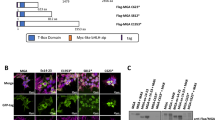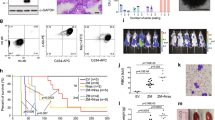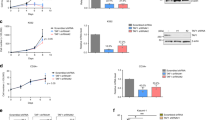Abstract
The leukemia-associated fusion gene AML1/MDS1/EVI1 (AME) encodes a chimeric transcription factor that results from the (3;21)(q26;q22) translocation. This translocation is observed in patients with therapy-related myelodysplastic syndrome (MDS), with chronic myelogenous leukemia during the blast crisis (CML-BC), and with de novo or therapy-related acute myeloid leukemia (AML). AME is obtained by in-frame fusion of the AML1 and MDS1/EVI1 genes. We have previously shown that AME is a transcriptional repressor that induces leukemia in mice. In order to elucidate the role of AME in leukemic transformation, we investigated the interaction of AME with the transcription co-regulator CtBP1 and with members of the histone deacetylase (HDAC) family. In this report, we show that AME physically interacts in vivo with CtBP1 and HDAC1 and that these co-repressors require distinct regions of AME for interaction. By using reporter gene assays, we demonstrate that AME represses gene transcription by CtBP1-dependent and CtBP1-independent mechanisms. Finally, we show that the interaction between AME and CtBP1 is biologically important and is necessary for growth upregulation and abnormal differentiation of the murine hematopoietic precursor cell line 32Dc13 and of murine bone marrow progenitors.
This is a preview of subscription content, access via your institution
Access options
Subscribe to this journal
Receive 50 print issues and online access
$259.00 per year
only $5.18 per issue
Buy this article
- Purchase on Springer Link
- Instant access to full article PDF
Prices may be subject to local taxes which are calculated during checkout









Similar content being viewed by others
References
Amann JM, Nip J, Strom DK, Lutterbach B, Harada H, Lenny N, Downing JR, Meyers S, Hiebert SW . 2001 Mol. Cell Biol. 21: 6470–6483
Bertos NR, Wang AH, Yang XJ . 2001 Biochem. Cell Biol. 79: 243–252
Chakrabarti S, Nucifora G . 1999 Biochem. Biophys. Res. Comm. 264: 871–877
Chakraborty S, Senyuk V, Sitailo S, Chi Y, Nucifora G . 2001 J. Biol. Chem. 276: 44936–44943
Cuenco GM, Nucifora G, Ren R . 2000 Proc. Natl. Acad. Sci. USA 97: 1760–1765
Du C, Redner RL, Cooke MP, Lavau C . 1999 Blood 94: 793–802
Grozinger CM, Hassig CA, Schreiber SL . 1999 Proc. Natl. Acad. Sci. USA 96: 4869–4873
Fears S, Mathieu C, Zeleznik-Le N, Huang S, Rowley JD, Nucifora G . 1996 Proc. Natl. Acad. Sci. USA 93: 1642–1647
Hast R, Nilsson C, Widell S, Ost A . 1989 Leuk. Res. 13: 173–178
Huang S . 1994 Cell 78: 9–
Izutsu K, Kurokawa M, Imai Y, Maki K, Mitani K, Hirai H . 2001 Blood 97: 2815–2822
Keller SA, Mao Y, Struffi P, Margulies C, Yurk CE, Anderson AR, Amey RI, Moore S, Ebels JM, Foley K, Corado M, Arnosti DN . 2000 Mol. Cell Biol. 20: 7247–7258
Kreider BL, Orkin SH, Ihle JN . 1993 Proc. Natl. Acad. Sci. USA 90: 6454–6459
Langenhuijsen MM . 1984 Br. J. Haematol. 58: 227–230
Lavau C, Luo RT, Du C, Thirman MJ . 2000 Proc. Natl. Acad. Sci. USA 97: 10984–10989
Lin RJ, Evans RM . 2000 Mol. Cell 5: 821–830
Mikhail FM, Serry KA, Hatem N, Mourad ZI, Farawela HM, El-Kaffash D, Coignet L, Nucifora G . 2002 Cancer Genet. Cytogenet in press
Minucci S, Maccarana M, Cioce M, De Luca P, Gelmetti V, Segalla S, Di Croce L, Giavara S, Matteucci C, Gobbi A, Bianchini A, Colombo E, Schiavoni I, Badaracco G, Hu X, Lazar MA, Landsberger N, Nervi C, Pelicci PG . 2000 Mol. Cell 5: 811–820
Nibu Y, Zhang H, Bajor E, Barolo S, Small S, Levine M . 1998 EMBO J. 17: 7009–7020
Nucifora G, Birn DJ, Espinosa 3rd R, Erickson P, LeBeau MM, Roulston D, McKeithan TW, Drabkin H, Rowley JD . 1993 Blood 81: 2728–2734
Nucifora G, Begy KR, Kobayashi H, Roulston D, Claxton D, Pedersen-Bjergaard J, Parganas E, Ihle JN, Rowley JD . 1994 Proc. Natl. Acad. Sci. USA 91: 4004–4008
Ogawa E, Inuzuka M, Maruyama M, Satake M, Naito-Fujimoto M, Ito Y, Shigesada K . 1993a Virology 194: 314–331
Ogawa E, Maruyama M, Kagoshima H, Inuzuka M, Lu J, Satake M, Shigesada K, Ito Y . 1993b Proc. Natl. Acad. Sci. USA 90: 6859–6863
Okuda T, van Deursen J, Hiebert SW, Grosveld G, Downing JR . 1996 Cell 84: 321–330
Palmer S, Brouillet JP, Kilbey A, Fulton R, Walker M, Crossley M, Bartholomew C . 2001 J. Biol. Chem. 276: 25834–25840
Postigo AA, Dean DC . 1999 Proc. Natl. Acad. Sci. USA 96: 6683–6688
Rhoades K, Hetherington CJ, Rowley JD, Hiebert SW, Nucifora G, Tenen DG, Zhang DE . 1996 Proc. Natl. Acad. Sci. USA 93: 11895–11900
Roulston D, Espinosa 3rd R, Nucifora G, Larson RA, Le Beau MM, Rowley JD . 1998 Blood 92: 2879–2885
Rubin CM, Larson RA, Anastasi J, Winter JN, Thangavelu M, Vardiman JW, Rowley JD, Le Beau MM . 1990 Blood 76: 2594–2598
Sambrook J, Fritsch EF, Maniatis T . 1989 Molecular cloning: a laboratory manual 2nd edn Cold Spring Harbor Laboratory: Cold Spring Harbor NY
Schaeper U, Boyd JM, Verma S, Uhlmann E, Subramanian T, Chinnadurai G . 1995 Proc. Natl. Acad. Sci. USA 92: 10467–10471
Sewalt R, Gunster M, Vlag J, Satijn D, Otte A . 1999 Mol. Cell Biol. 19: 777–787
Soderholm J, Kobayashi H, Mathieu C, Rowley JD, Nucifora G . 1997 Leukemia 11: 352–358
Sood R, Talwar-Trikha A, Chakrabarti SR, Nucifora G . 1999 Leukemia 13: 348–357
Sundqvist A, Sollerbrant K, Svensson C . 1998 FEBS Lett. 429: 183–188
Turner J, Crossley M . 1998 EMBO J. 17: 5129–5140
Turner J, Crossley M . 2001 BioEssays 23: 683–690
Wang Q, Stacy T, Binder M, Marin-Padilla M, Sharpe AH, Speck NA . 1996 Proc. Natl. Acad. Sci. USA 93: 3444–3449
Zent C, Kim N, Hiebert S, Zhang DE, Tenen DG, Rowley JD, Nucifora G . 1996 Curr. Top. Microbiol. Immunol. 211: 243–252
Zent C, Rowley JD, Nucifora G . 1997 Leukemia 11: Suppl 3 273–278
Zhang DE, Hetherington CJ, Meyers S, Rhoades K, Larson CJ, Chen HM, Hiebert SW, Tenen DG . 1996 Mol. Cell Biol. 16: 1231–1240
Acknowledgements
We thank Ms S Sitailo for technical assistance. We thank Dr R Baer (Columbia University) for the CtBP1-Flag-pCMV plasmid and Dr SL Schreiber (Harvard University) for the HDACs-Flag-pBJ5.1 plasmids. This work was supported by NIH-NCI grants CA67189 and CA72675 (G Nucifora), and by a translation research award from the Leukemia and Lymphoma Society (G Nucifora). G Nucifora is a Scholar of the Leukemia and Lymphoma Society.
Author information
Authors and Affiliations
Corresponding author
Rights and permissions
About this article
Cite this article
Senyuk, V., Chakraborty, S., Mikhail, F. et al. The leukemia-associated transcription repressor AML1/MDS1/EVI1 requires CtBP to induce abnormal growth and differentiation of murine hematopoietic cells. Oncogene 21, 3232–3240 (2002). https://doi.org/10.1038/sj.onc.1205436
Received:
Revised:
Accepted:
Published:
Issue Date:
DOI: https://doi.org/10.1038/sj.onc.1205436
Keywords
This article is cited by
-
The transrepression and transactivation roles of CtBPs in the pathogenesis of different diseases
Journal of Molecular Medicine (2021)
-
Role of HDACs in normal and malignant hematopoiesis
Molecular Cancer (2020)
-
EVI1 phosphorylation at S436 regulates interactions with CtBP1 and DNMT3A and promotes self-renewal
Cell Death & Disease (2020)
-
Fadd and Skp2 are possible downstream targets of RUNX1-EVI1
International Journal of Hematology (2013)
-
AML1-Evi-1 specifically transforms hematopoietic stem cells through fusion of the entire Evi-1 sequence to AML1
Leukemia (2008)



